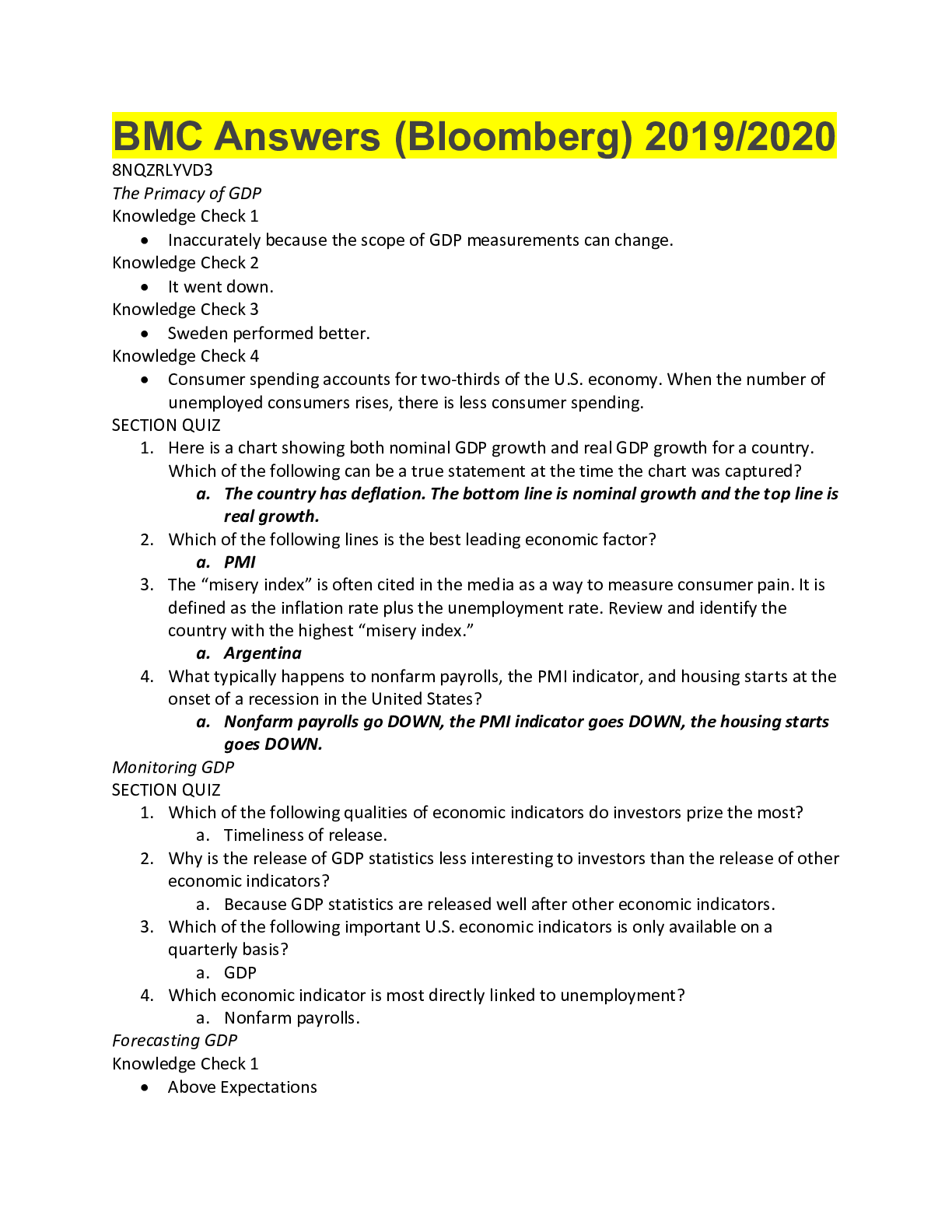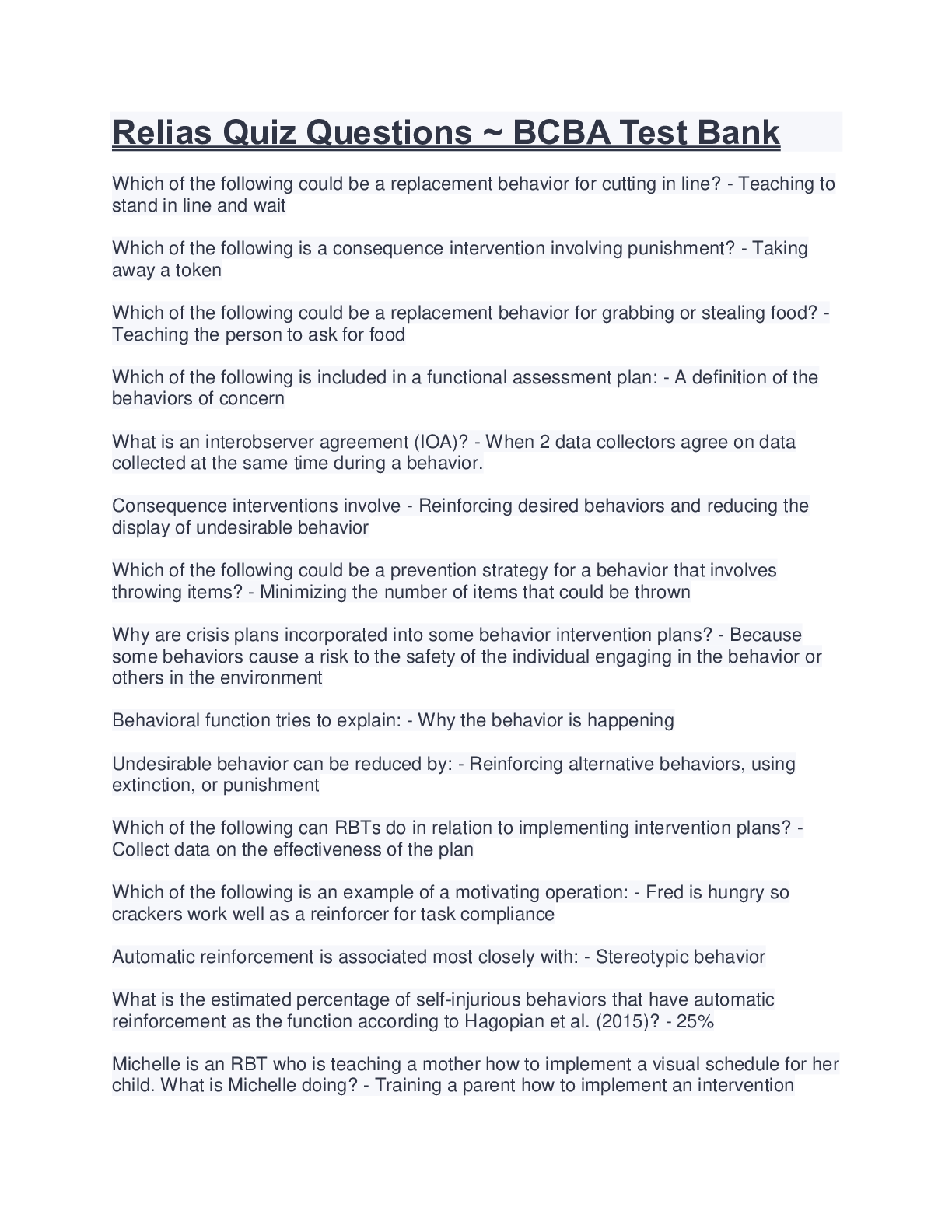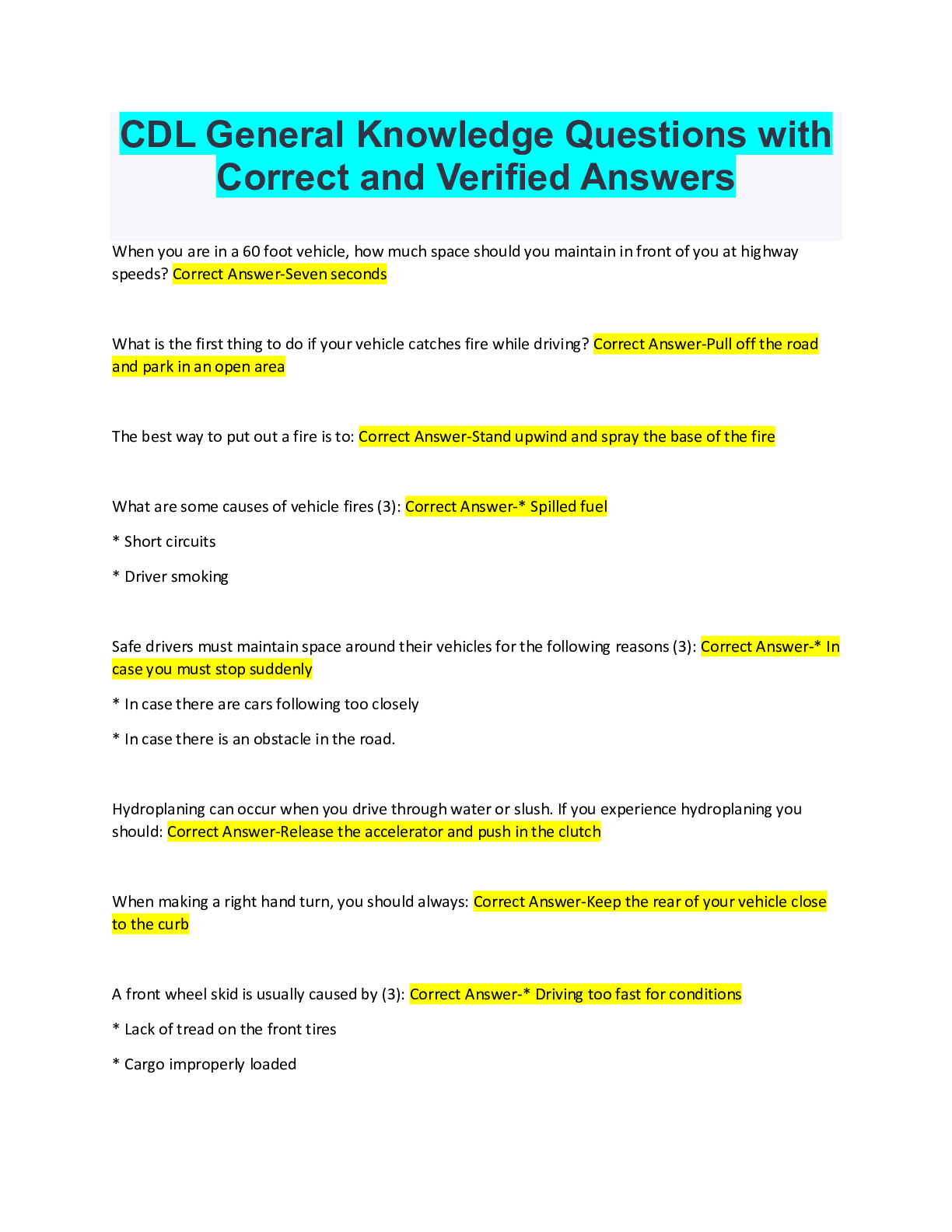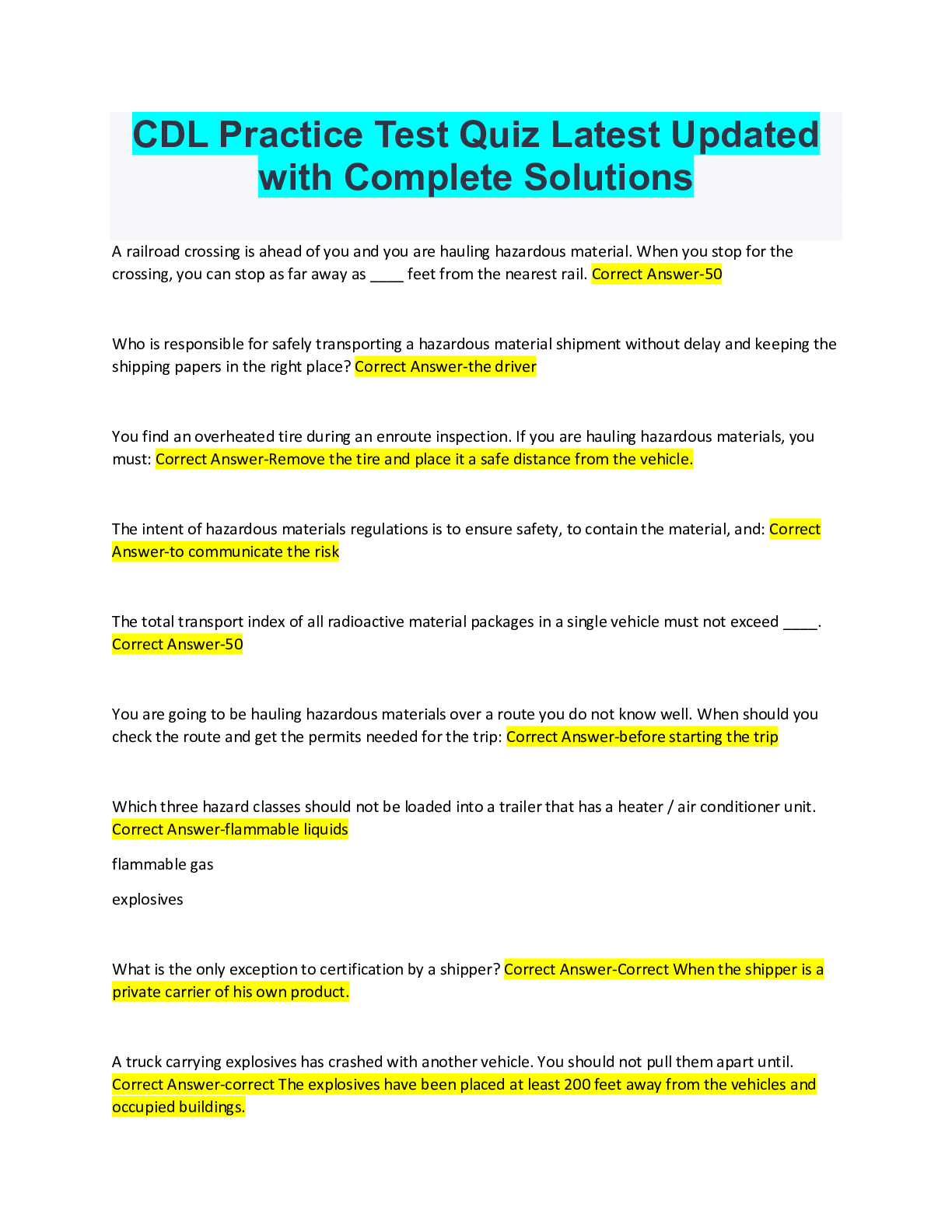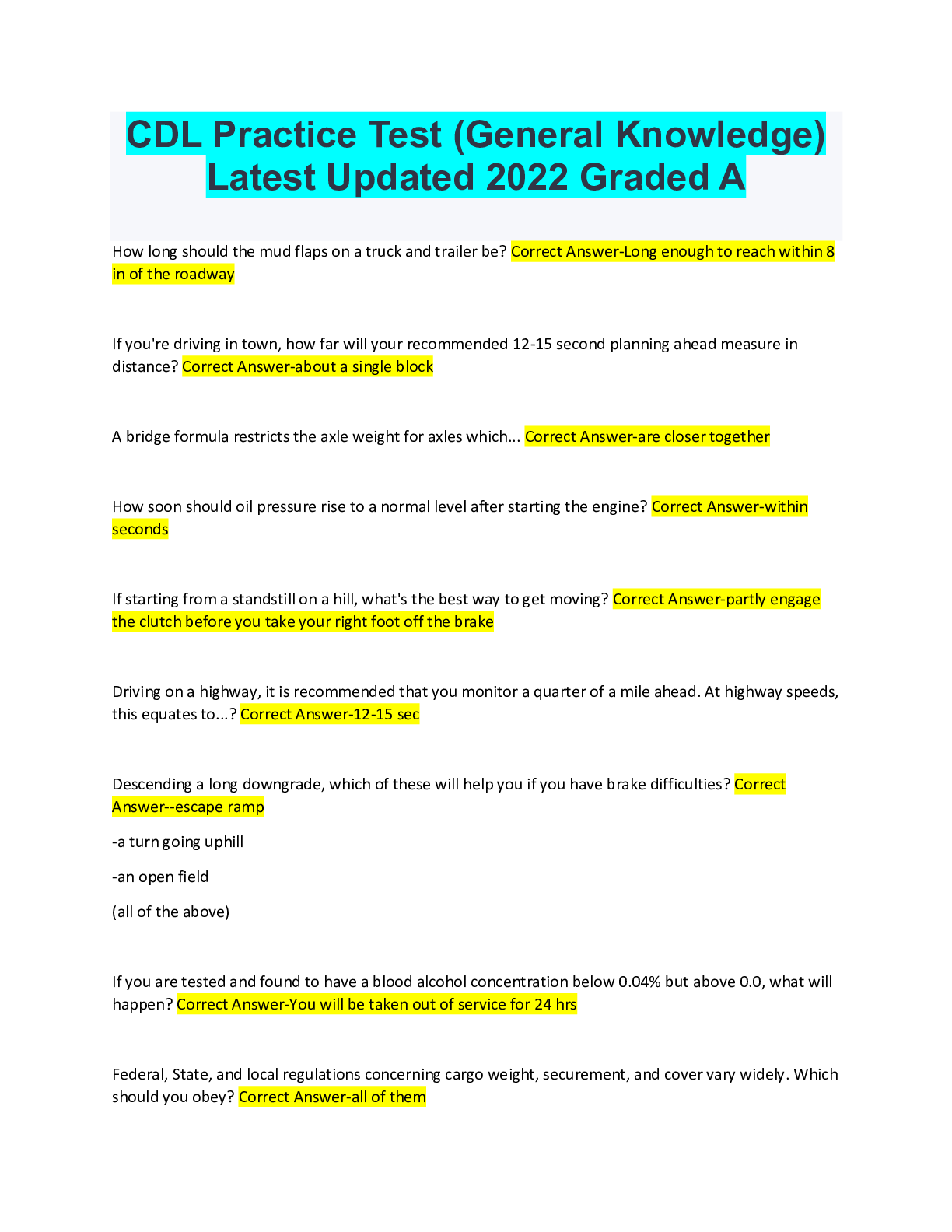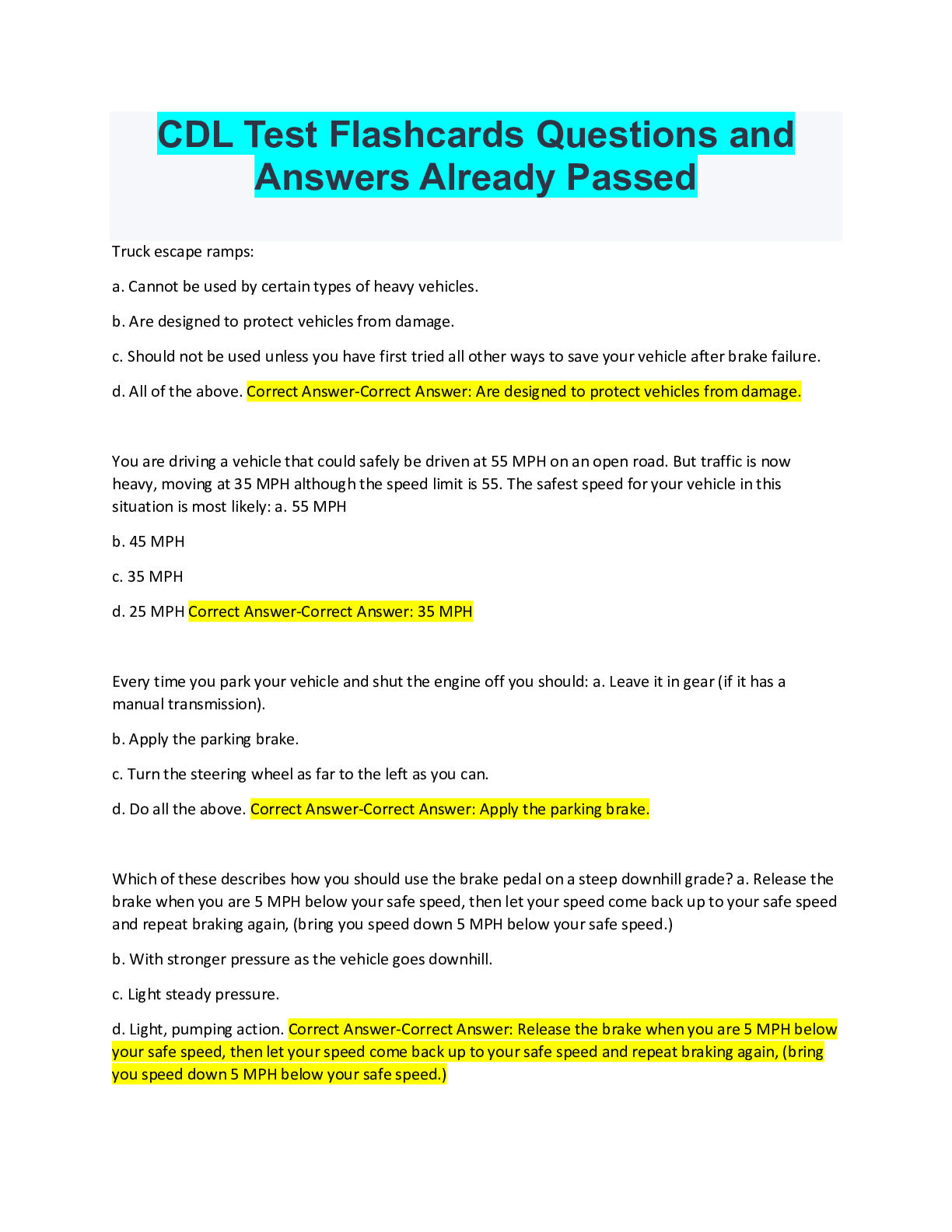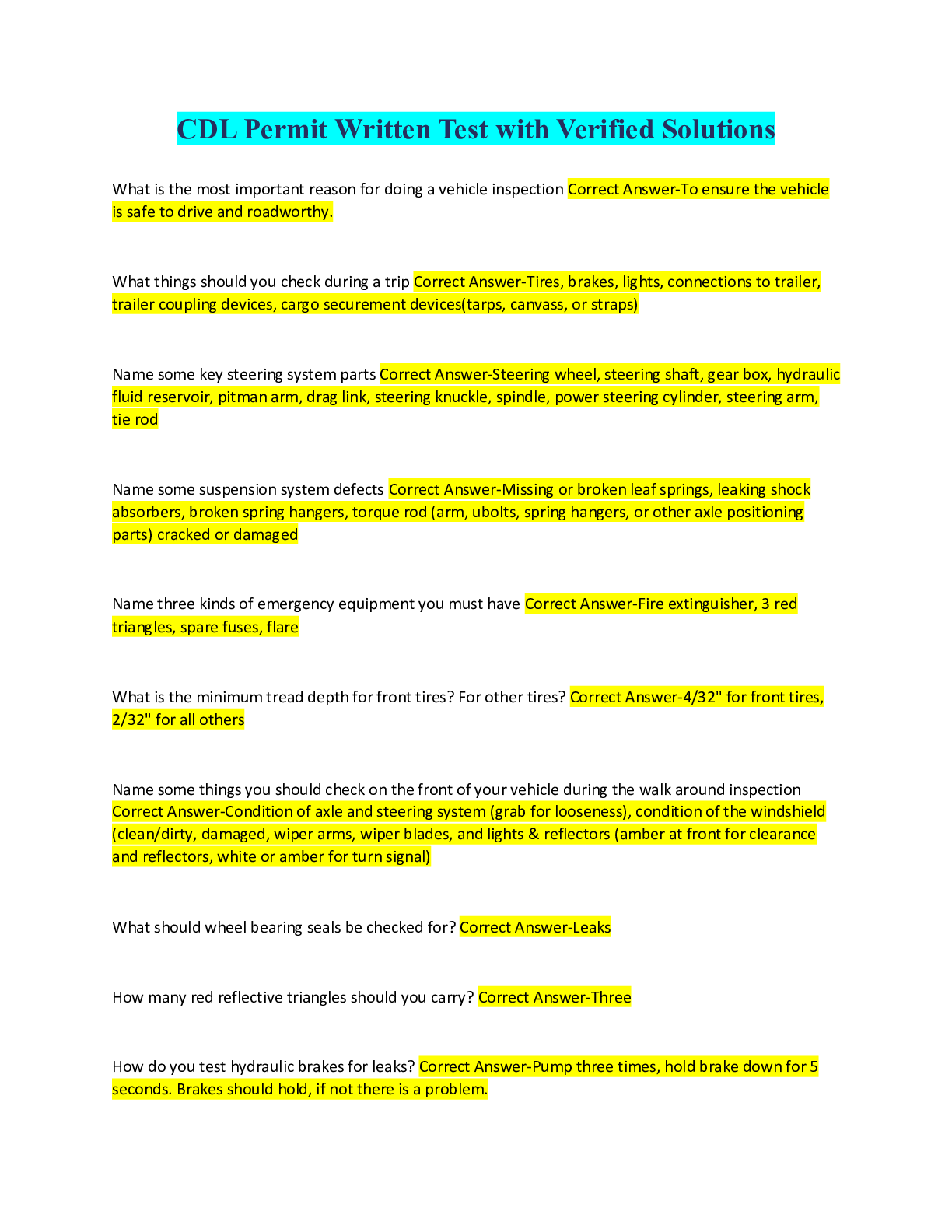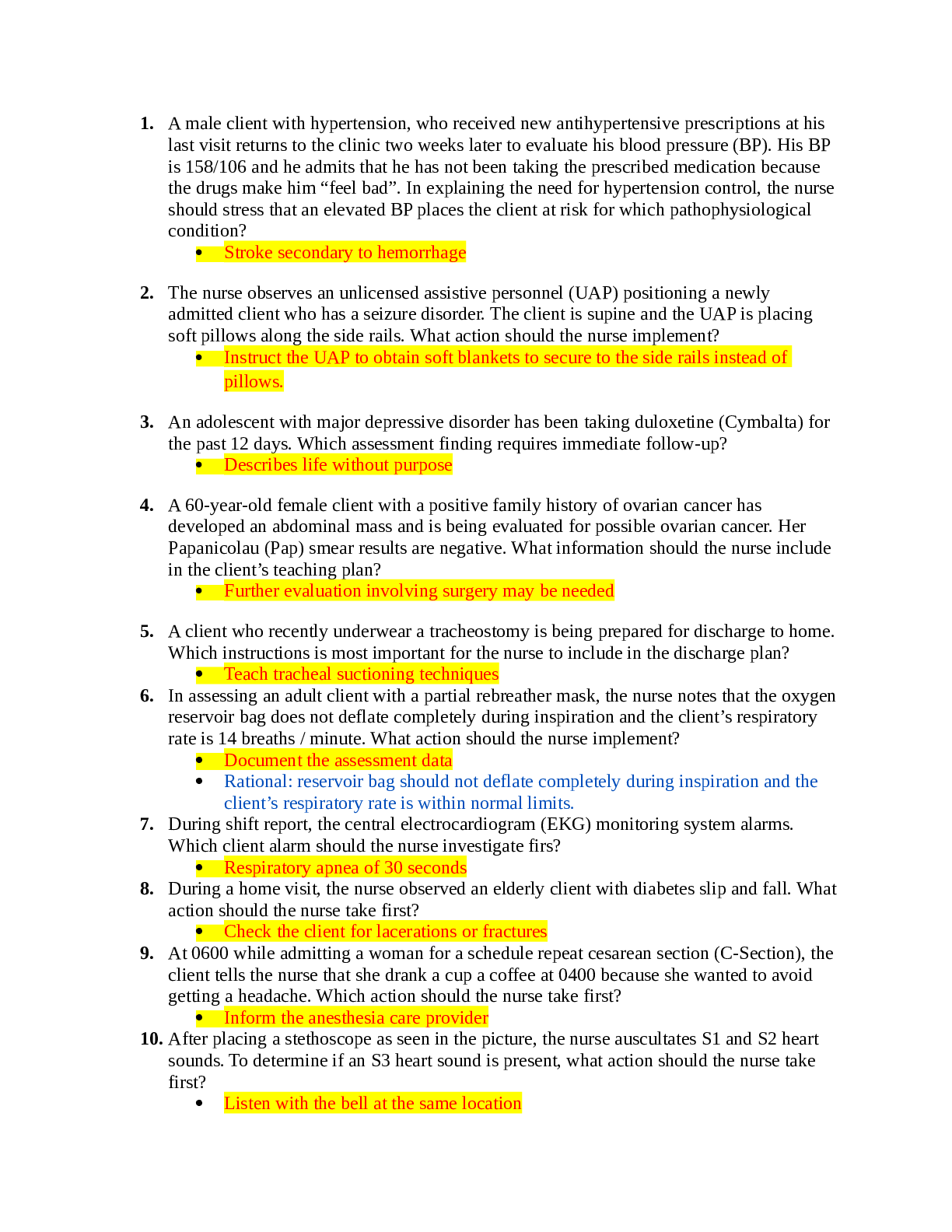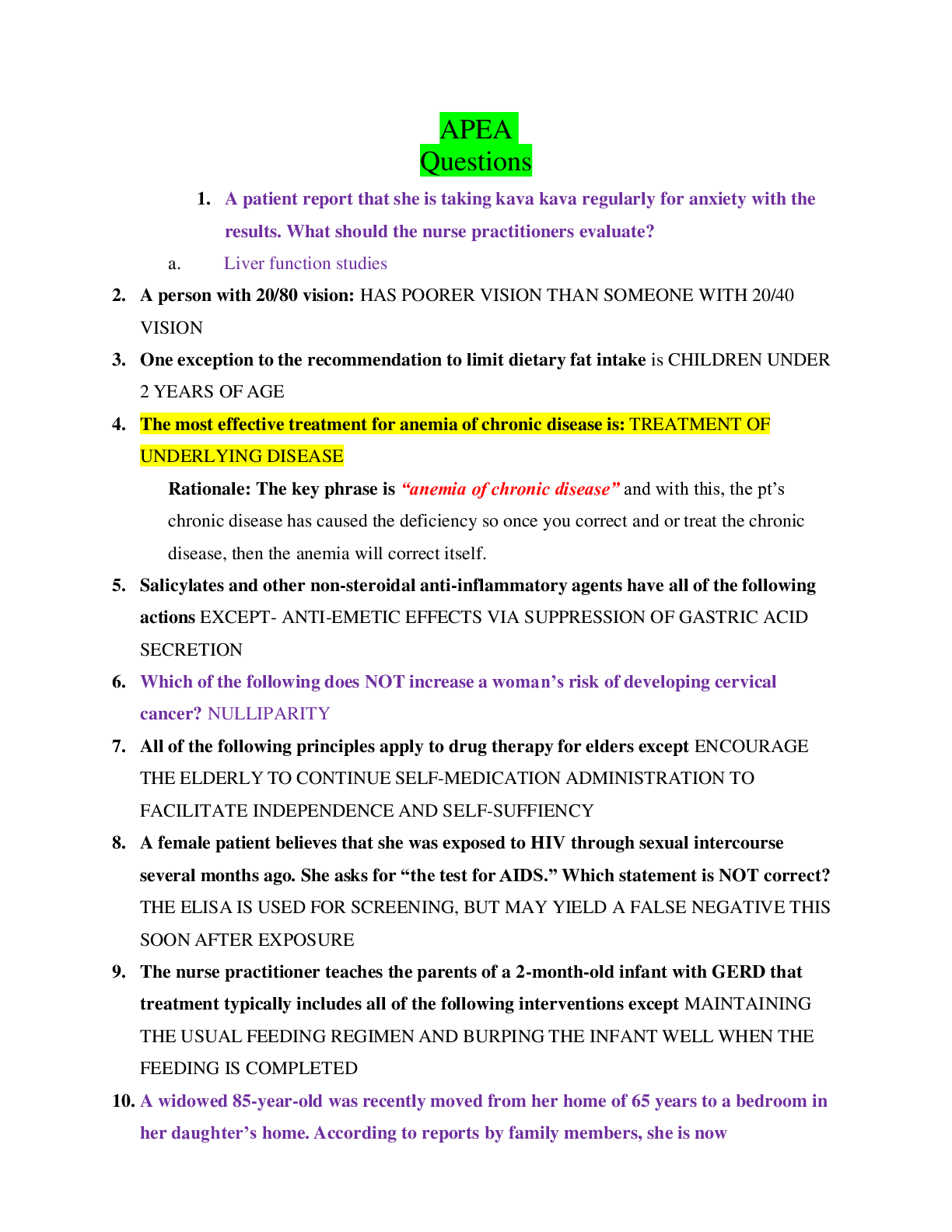Medical Studies > QUESTIONS & ANSWERS > EMT Final Exam (All)
EMT Final Exam
Document Content and Description Below
EMT Final Exam 833 - Your 36 y/o pt is unresponsive upon attempting to insert an OPA, the patient gags, You should A. Insert a nasal airway B. Suction the oropharynx C. Reattempt using a smaller ... oral adjunct D. Insert a dual lumen airway - ✔✔A. Insert a nasal airway 903 - After air passes through the vocal cords during inhalation, which structure does it reach next? A. Trachea B. Epiglottis C. Alveolus D. Bronchus - ✔✔A. Trachea 906 - You are ventilating an apneic asthmatic pt with a BVM. The patient has inadequate chest rise. You should A. Decrease the rate of ventilations to 10/min B. Use an O2 powered ventilation device C. Increase the forcefulness of ventilations D. Increase the rate of ventilations to 20/min - ✔✔A. Decrease the rate of ventilations to 10/min 909 - A 72 y/o female pt is unresponsive following an ejection from a MVC, she has an open jaw fracture and a dialated right pupil. What is the best way to open this pt's airway A. Insert an OPA B. Perform a modified head tilt chin lift C. Insert a NPA D. Perform jaw thrust - ✔✔C. Insert a NPA 910 - A 4-Year-old female tracheostomy pt has pulled out her tracheostomy tube. The opening is partially obstructed with skin. You should A. Use a soft tip catheter and suction until clear B. Insert a nasal airway into stoma C. Wipe the area clean and perform mouth to stoma ventilation D. Cut the skin away from the stoma - ✔✔A. Use a soft tip catheter and suction until clear 908 - You are using a BVM and an OPA on an apneic pt. Suddenly it becomes difficult to ventilate. You should first suspect that A. The patients diaphragm has contracted B. The pt has an airway obstruction C. The Pt is becoming more responsive D. The pt's lungs have collapsed - ✔✔B. The pt has an airway obstruction 946 - A 60-year-old pt with stoma is apneic. You have been suctioning pink frothy sputum for 10 seconds and you continue to get more material. You should A. continue suctioning and have a partner ventilate through the pt's mouth B. suction until airway is clear C. stop suctioning and give a breath D. use a saline solution to moisten secretions and continue suctioning - ✔✔C. stop suctioning and give a breath 947 - victim of smoke inhalation has developed difficulty breathing. He does not like the smell of the mask you are using to deliver O2. You should A. Switch to a NC set to deliver O2 @ 6 LPM B. Restrain the pt and continue administering O2 via NRB C. Explain that the mask is very important and continue its use D. Administer blow-by O2 via Simple mask - ✔✔C. Explain that the mask is very important and continue its use 948 - An unresponsive 82 y/o pt is lying supine. Their airway is most likely to be obstructed by A. loose dentures B. Secretions C. The tongue D. Swelling of the epiglottis - ✔✔C. The tongue 949 - You are inserting an OPA into a 4 y/o pt you should A. Use a tongue depressor to keep tongue out of the way B. Use a head tilt chin lift C. Insert the tip pointing toward the roof of the mouth D. Use an airway that measures one size too small and rotate - ✔✔A. Use a tongue depressor to keep tongue out of the way 951 - Initial assessment reveals an alert adult pt who is SOB. He is seated in a tripod position using accessory muscles to breathe. Vital signs are BP 140/80 P 110, R 22 with crackles, SpO2 95%. You should A. Administer O2 via NRB B. Ventilate the pt with a BVM to slow respirations C. Administer O2 via NC D. Monitor pulse oximetry - ✔✔A. Administer O2 via NRB 952 When suctioning a patient, you should A. Suction on the way in for no more than 5 seconds B. Suction on the way out for no more than 15 seconds C. Suction on the way in for no more than 15 seconds D. Suction on the way out for no more than 5 seconds - ✔✔B. Suction on the way out for no more than 15 seconds 1139 - Which of the following is the most appropriate way to measure for an OPA? A. From the patient's earlobe to angle of the jaw B. From the center of pt's mouth to earlobe C. From the corner of the pt's mouth to the earlobe D. From the tip of pt's nose to earlobe - ✔✔C. From the corner of the pt's mouth to the earlobe 1141 - How should you ventilate an apneic adult pt? A. Perform mouth to mask ventilation 12 breath per minute B. Ventilate with a flow restricted PPV at 12-20 breaths per minute C. Ventilate once every 5-6 seconds with a bag valve mask D. Ventilate once every 3 seconds with a BVM - ✔✔C. Ventilate once every 5-6 seconds with a bag valve mask 1142 - Your pt was involved in a MVC he is unresponsive and you hear snoring respirations when he breathes. You should perform a A. Head tilt neck lift with c-spine stabilization B. Jaw thrust with c-spine stabilization C. Tongue jaw lift with c-spine stabilization D. Head tilt lift with c-spine stabilization - ✔✔B. Jaw thrust with c-spine stabilization 1145 - A 67-year-old female is short of breath and sitting in a tripod position. She is on home oxygen and has had a productive cough over the last few days. During your exam, you note that she is wheezing and breathing with pursed lips. SPO2 is 93%. You should suspect A. Anaphylactic reaction B. Obstructive pulmonary disease C. AMI D. Pulmonary embolism - ✔✔B. Obstructive pulmonary disease 1338 - Which of the following indicates the correct flow range and delivery percentage for NC? A. 1-6 LPM / 44% B. 10-15 LPM / 95% C. 2-8 LPM / 28% D. 2-4 LPM / 35% - ✔✔A. 1-6 LPM / 44% 1348 - Allowing for appropriate exhalation when assisting ventilations can reduce/alleviate A. The amount of air required to ventilate B. Secretions when suctioning the pt's airway C. Airway obstructions D. Gastric distention- - ✔✔D. Gastric distention 1350 - Which of the following is TRUE about the insertion of an OPA? A. If properly inserted the OPA will keep the tongue out of the airway B. The OPA should be inserted until the flange rests below the patient's teeth C. The OPA is always rotated 360 degrees as it is inserted D. The OPA is measured between the patient earlobe and nose - ✔✔A. If properly inserted the OPA will keep the tongue out of the airway 1351 - Which of the following statements regarding suctioning of an adult is TRUE? A. You should start ventilations if suction cannot clear the airway B. You should only suction for a max of 30 seconds C. You should insert the suction catheter only as far as you can visualize D. You should remove the suction catheter with the suction machine turned off - ✔✔C. You should insert the suction catheter only as far as you can visualize 1352. You are called to an elderly male who is having trouble breathing. Respirations are at a rate of 24 and labored and the pt is cyanotic. Your pt is conscious but unable to speak in full sentences. Enroute to the hospital your pt goes into respiratory arrest. You should. A. use a pocket mask and begin chest compressions B. Assist ventilations with BVM and room air. C. Assist ventilations with BVM and 100% O2 D. Start oxygen at 15 LPM via NRB - ✔✔C. Assist ventilations with BVM and 100% O2 1353 - What are two manual methods of opening a patient's airway? A. Head tilt-chin lift and NPA B. Head tilt chin lift and OPA C. Jaw thrust and finger sweep D. Head tilt and jaw thrust - ✔✔D. Head tilt and jaw thrust 1358 - What is the amount of air moved with one normal breath called? A. Dead air space B. Minute volume C. Alveolar air D. Tidal volume - ✔✔D. Tidal volume 1360 - What does pulse oximetry measure? A. Percent of carbon dioxide in the cells B. Percent of tissue that is saturated with oxygen C. The amount of plasma that is saturated D. The amount of hemoglobin that is saturated usually with oxygen. - ✔✔D. The amount of hemoglobin that is saturated usually with oxygen. 1804 - When opening the airway of an unconscious pt found lying in bed you should A. Place one hand on the forehead with fingertips of the other hand pinching the nose B. Place one hand on the forehead with the other hand on the angle of the jaw C. Place the right hand on the base of the neck and left hand under the angle of the jaw and tip head backward D. Place both hands at base of neck and tip head backward to fully extend the neck. - ✔✔B. Place one hand on the forehead with the other hand on the angle of the jaw 1807 - Your pt is pale and seems anxious but is speaking in full sentences. You should administer O2 using a A. flow restricted O2 powered ventilation device B. NRB @ 15 LPM C. NC @ 4 LPM D. BVM @ 15 LPM - ✔✔B. NRB @ 15 LPM 1819 - Your 92 y/o pt is SOB, unable to speak, and cyanotic. You should first A. Assure the patient has an open airway B. Ventilate the pt with BVM C. Administer O2 via NRB D. Administer the prescribed bronchodilator - ✔✔A. Assure the patient has an open airway 1820 - Your 73 y/o pt is sitting in the tripod position. As you approach they motion for assistance in using their inhaler. You should immediately A. Administer their prescribed inhaler B. Administer O2 via NRB C. Assess the pt's airway status D. Ventilate with a BVM - ✔✔C. Assess the pt's airway status 1934 - While ventilating a near drowning pt, you suddenly feel increased resistance in the airway. You should A. Perform abdominal thrust B. Place pt in lateral recovery position C. Attempt to reposition the head D. Apply firm pressure to the abdo [Show More]
Last updated: 1 year ago
Preview 1 out of 33 pages
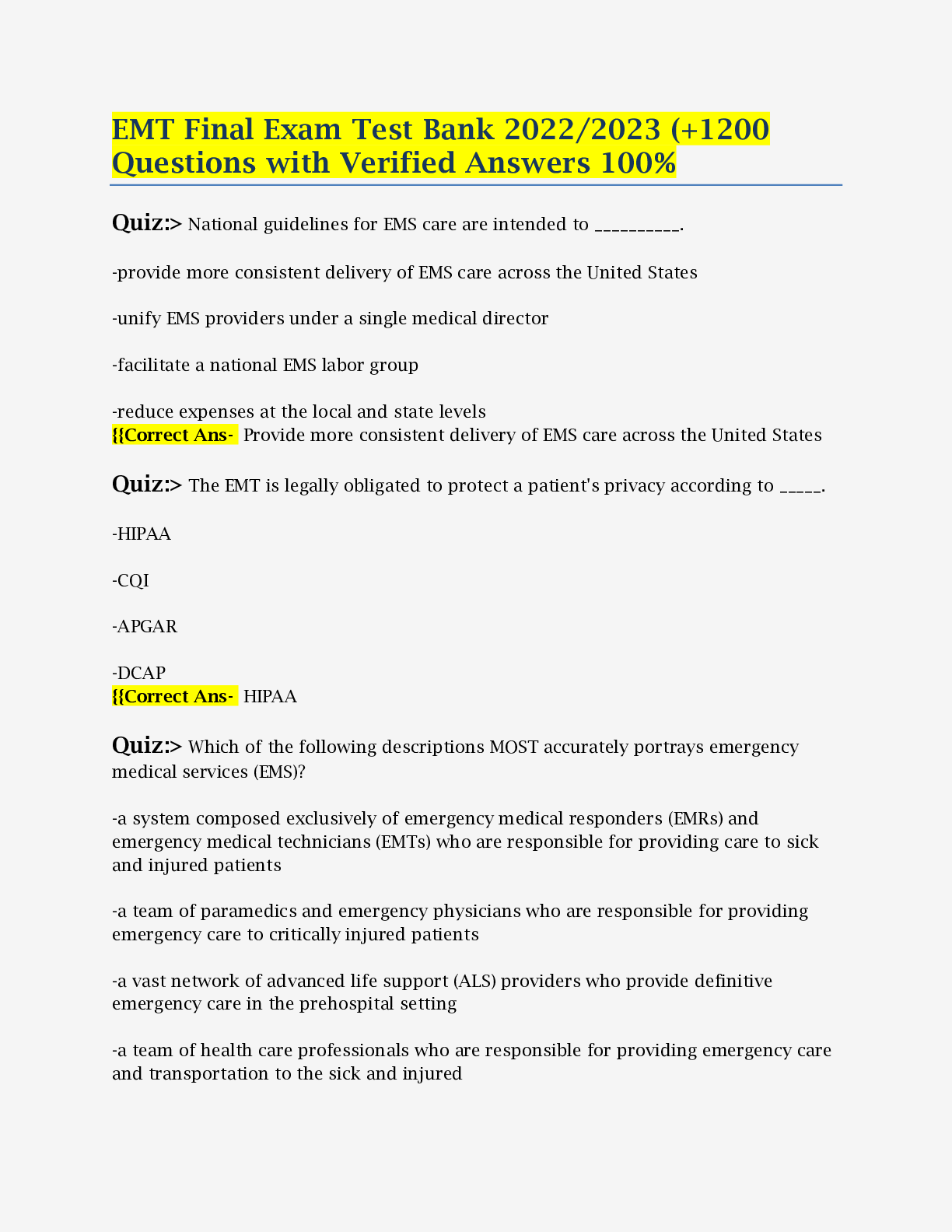
Reviews( 0 )
Document information
Connected school, study & course
About the document
Uploaded On
Aug 27, 2022
Number of pages
33
Written in
Additional information
This document has been written for:
Uploaded
Aug 27, 2022
Downloads
0
Views
71

.png)
.png)
.png)
.png)
.png)
.png)
.png)
.png)
.png)
.png)
.png)

.png)

.png)
.png)
